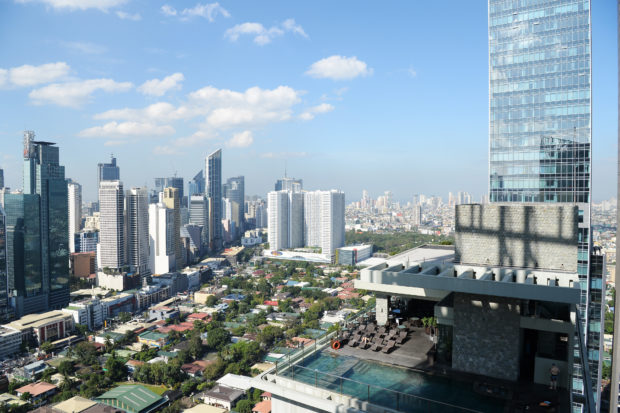Weeks before Duterte gone, PH debt hits new high in March: P12.68 trillion

This photo taken on January 29, 2019 shows a general view of the skyline of the financial district of Makati in Manila. (Photo by Ted ALJIBE / AFP)
MANILA, Philippines—A combination of two commercial borrowings through bond issuances — one each in the domestic and offshore debt markets — jacked up the national government’s outstanding debt to a new high of P12.68 trillion in March.
The latest Bureau of the Treasury (BTr) data on Thursday (May 5) showed that outstanding obligations climbed 4.8 percent from P12.09 trillion in February. Year-on-year, the end-March debt pile was 17.7-percent higher than P10.77 trillion in 2021.
Outstanding domestic obligations accounted for bulk—or 69.9 percent of total. Locally sourced debt rose 5.4 percent month-on-month and jumped 14.5 percent year-on-year to P8.87 trillion.
In a report, the BTr attributed the higher end-March domestic debt to the P457.8 billion raised from five-year retail treasury bonds (RTBs) that month — the Duterte administration’s 10th and likely last RTB issuance. Borrowings through RTB were being pitched as “investments” in government securities among individuals and small groups.
It was also in March when the Philippines borrowed P117.3 billion through US dollar-denominated global bonds across three tenors, including the country’s first-ever “green” bonds aimed at financing climate mitigation and adaptation programs.
Article continues after this advertisementThe global bond issuance last March helped hike foreign debt by 3.6 percent month-on-month and 25.8 percent year-on-year to P3.81 trillion.
Article continues after this advertisementIncluding proceeds from the dollar-denominated bonds, a net of P122.7 billion in external borrowings were recorded in March. It did not help that the peso weakened to 51.906:$1 from February’s exchange rate of 51.385 against the US dollar, which added P37.3 billion to the debt stock notwithstanding a P29.2-billion reduction coming from adjustments in Philippine debts denominated in currencies other than the greenback.
BTr data showed that as of end-March, 69.8 percent of the Philippines’ debt amounting to P8.85 trillion were peso-denominated, as the government borrows more from local creditors to temper foreign exchange risks while taking advantage of flushing liquidity here.
The bulk of outstanding obligations had been sourced commercially through debt securities, which reached P10.69 trillion as of March, while loans amounted to a smaller P1.98 trillion.
By maturity, the national government’s debt was mostly long-term or maturing in over 10 years, with P8.14-trillion worth, or 65.7 percent of total.
With P2.2 trillion in gross borrowings programmed for 2022, of which three-fourths or P1.65 trillion will be sourced from domestic creditors mainly through the issuance of treasury bills and bonds, outstanding debt was expected to hit a new annual record-high of P13.42 trillion by end-2022, from P11.73 trillion in 2021.
Despite expectations of 7 to 9 percent gross domestic product (GDP) growth this year, the debt-to-GDP ratio was expected to slightly rise to 60.9 percent of GDP, from the 16-year-high of 60.5 percent last year. In emerging markets like the Philippines, credit rating agencies considered public debt as manageable at the 60-percent-of-GDP level.
“The end-2021 level is still in line with prudent bounds of fiscal viability and the experience of the Philippines’ [credit] rating peers,” the Department of Finance (DOF) said in its 2021 annual report published last May 3.
As the Philippines kept its investment-grade credit ratings intact despite the prolonged pandemic, the DOF said the national government “had the headroom to contract new debt at lower interest rates and costs.”
“Recognizing [the Philippines’] efforts at maintaining fiscal discipline and ensuring prudence in public expenditure, multilateral financial institutions and commercial markets remain very supportive of the national government’s financing program,” the DOF said.
As far as external financing was concerned, the DOF said that under the Duterte administration, the government contracted a total of 120 loans and global bonds offerings worth $50.8 billion from July 2016 to December 2021.
Nearly three-fourths of total foreign borrowings from mid-2016 to end-2021 amounting to $37.2 billion — $15.4-billion worth of program loans, plus $21.8 billion raised from global bonds offerings — had been injected into the national budget, DOF data showed.
Also, “a total of 54 project loans amounting to around $13.5 billion have been contracted in support of infrastructure flagship projects under the ‘Build, Build, Build’ program, as well as other priority sectoral initiatives and COVID-19 response” as of December last year, the DOF said. For big-ticket projects under the ambitious Build, Build, Build infrastructure program alone, the government borrowed $8.8 billion across 27 concessional or low-interest loans as of 2021.
“Japan leads as the largest development partner for the national government’s direct and guaranteed project loans under the Duterte administration (40 percent of total project loans), followed by the Asian Development Bank (25 percent), and the World Bank (21 percent),” the DOF said.
The DOF said that “external debt provided adequate headroom for disbursements needed for COVID-19 response, including vaccine financing.” Foreign borrowings to bankroll the war chest against the prolonged pandemic reached $25.7 billion, or P1.31 trillion, as of mid-January, which the DOF had said will take 40 years, or about two generations, to repay.
The DOF will pitch a comprehensive fiscal consolidation and resource mobilization plan to the next administration to pay for the ballooning debts and narrow the yawning budget deficits wrought by COVID-19.
Various economic officials had said fiscal consolidation could include new or higher taxes, spending cuts on non-priority sectors, and drivers to robust GDP growth.